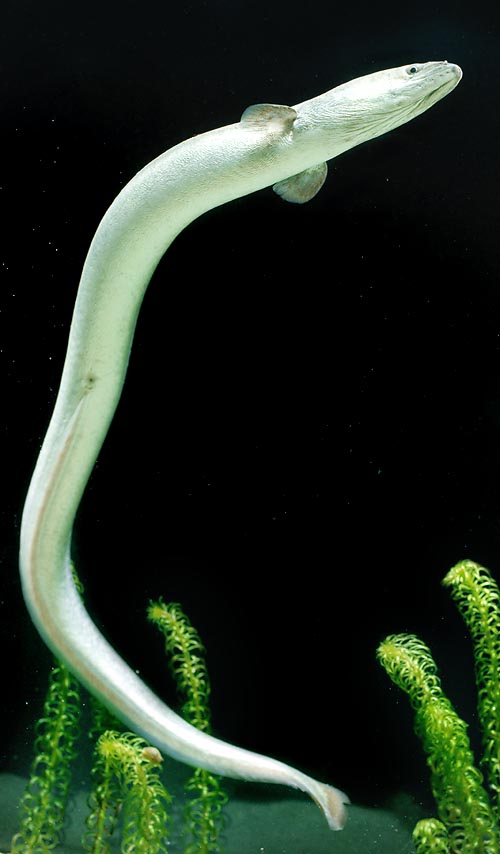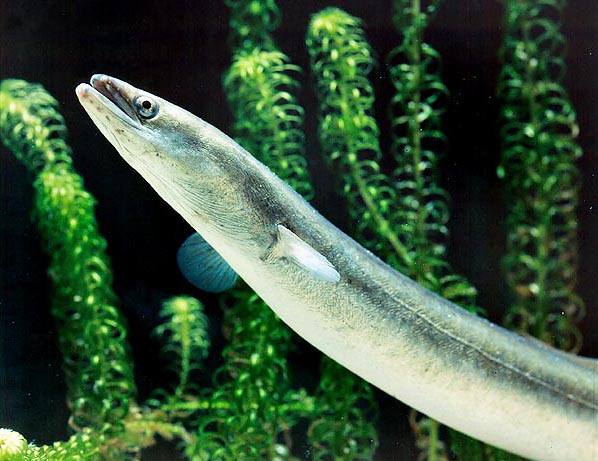Family : Anguillidae

Text © DrSc Giuliano Russini – Biologo Zoologo

English translation by Mario Beltramini

Anguilla anguilla may exceed the 50 years and the 10 kg of weight © Giuseppe Mazza
The order of the Anguilliforms (Anguilliformes), counts about 300 species of fishes among eels and morays.
The main species of eel are divided into two groups, the strain of the European eel (Anguilla anguilla Linnaeus, 1758) and the strain of the American eel (Anguilla rostrata Lesueur, 1817).
Several races or subspecies are also to be considered.
These fishes belong to the important class of the Osteichthes (Osteichthyes), the bony fishes.
The economical importance of the eel, from the alimentary point of view, is remarkable: the industrial fishing, done by means of particular fishing basins, called “lavorieri”, is much thriving in Italy, especially in the Valleys of Comacchio.
In this location, the big non migrant females are bred; they may reach even the 10 kg of weight and the 50 years of life.
The whole of these techniques and of the principles standing at the base of the eel breeding unite under the name of “vallicoltura” (lagoon fish breeding) and is referred also the breeding of the mullets.
The lagoon fish breeding is a practice of breeding included in the more general “pisciculture” or “aquaculture”.
Zoogeography
They are fishes with a world-wide distribution, even if the biologists, by means of zoogeographic analysis and of genetics of population, seem to be driven to consider as origin centre of these fishes (both the Anguilla anguilla and the Anguilla rostrata) the western Atlantic.
Habitat-Ecology
They are double life fishes, like the salmons (anadromous species), as they spend part of their life in the rivers, in the form of an organism able to live in freshwaters.
But, as the great American ichthyologist biologist N.B. Marshall, they are fishes also with “catadromous” nature, as, unlike salmons, which reproduce reaching the rivers of origin, the Anguilla anguilla and the Anguilla rostrata, have their vital cycle reversed, that is, they go down the rivers for reaching and reproducing in the same area of sea where they were born (western Atlantic, Sargasso Sea). But the American biologist goes beyond this, and defines them, during his studies in the fifties of the XX century, as “potamodromous” fishes and “thalassodromous”, because the “Leptocephalus”, the ribbon-like, transparent, metamorpho- sing larva (the eels, being fishes with indirect development, pass through a larval status, the embryo), which forms from the zygote deriving from the fecundated ovo cell, migrates in the various rivers where the parents have spent part of their life, for growing up, develop and metamorphose.
And since for completing each one of these stages, among which also the sexual maturation, which will lead them to go down the rivers for going to reproduce, they have nourished quite a lot in the rivers, in order to get the right protein load of fatty acids and carbohydrates, the Marshall thinks that they should therefore be defined as “potamodromous”: that is, nourishing in the river. Ando, to finish, seen that the reproduction takes place at sea and represents the most important moment of the life, that which, through the perpetuation and the endlessly propagation of the own alleles or genes through the progeny, they should be also called “thalassodromous”. Basically, for the American biologist N.B. Marshall, the Anguilla anguilla as well as the Anguilla rostrata are species of bony fishes: catadromous, potamodromous, and thalassodromous (for more information, also about the mechanism of the Homing, please refer to the introduction to the PISCES).
They are found in all the rivers of the world, Italian ones included, reaching also river areas close to the Arctic Polar Circle. When in the freshwaters of the rivers, they love the calm locations, rich in vegetation, with muddy bottom, thus avoiding the sources. They stay crouched during the day, and get out the night looking for preys. They are very greedy. They nourish mainly of fishes, crustaceans, molluscs and water insects, but also of terrestrial animals, like molluscs, earthworms, insects, etc. carrions included.
If out from their element, they are very resistant, also because the presence of pre-branchial chambers where a certain quantity of water and oxygen are stored; they will mix thus allowing them to live, for a certain period in the sub-aerial environment. This is well known by the fishmongers as when, by a chance, an eel falls on the ground, escapes very agile and to seize it becomes a real challenge. This peculiarity often allows them, in the wild, to go seeking new reservoirs: thus covering quite remarkable distances in the terrestrial environment, successfully overcoming obstacles of every sort, even to climb on shrubs of medium height! These displacements in the sub-aerial environment happen especially during the rains, or however, in conditions of strong humidity. The eels spend their winter dormancy wrapped in the humid mud.

The eel blood is venomous, but its much toxic principle disperses in cooking © Giuseppe Mazza
Morpho-Physiology
The body of the eels is serpentiform; very small elliptic scales are incorporated into the thick and mucous skin and are equipped with not thorny fins.
In the specific, it is matter of the anal and dorsal ones, united to the caudal. The body has an elongated shape and on is evident a pair of small eyes.
The blood of the Anguilla anguilla contains a highly toxic principle, which, from laboratory tests made on experimental animals, would seem capable to compete with the venom of the vipers! But it loses every power after cooking (thermolabile).
They may reach, especially the females, a length of 1,50 m and weigh several kilos. Once adult, after about 6 years (after some biologists, after others the sexual maturation takes place when about 10-12 years old), alternating phases of life in water to moments of sub-aerial life, the cease completely nourishing, getting an atrophy of the digestive apparatus. When at this stage, the males are about 50 cm long, the females even 1,50 m. Due to the reproductive instinct, males and females as well, move, going down the rivers, towards the sea. In this period, their colour, before yellowish, has become silvery; it is so possible to understand, taking samples of them, if they are going to reproduce.
Ethology-Reproductive Biology
Once finally reached the sea, the members of both sexes move towards the Sargasso Sea, in some cases covering a distance of almost 4.000 km! Once there, at some hundreds of metres of depth, the females lay several eggs, immediately inseminated by the males. The newly born larvae, “Leptocephali”, thought to be, till the beginning of the ‘900 by the biologists to form an independent genus of fishes, a few millimetres long, transparent and lanceolate small leaf shaped, or called also ribbon-like, begin to carry on their own life. Two-three years later, nourishing of plankton, the larvae of Anguilla anguilla reach the European coasts, transported passively by the Gulf Stream. At this moment, the Leptocephali get a heavy metamorphose and assume a look similar to the adult and a length of about 10 cm. At this stage, the eels are erroneously defined as “blind”, even if they have perfectly operating eyes. The “blind” stay initially close to the coasts then, as soon as grouped in great number at the rivers mouths, they go up the tiver.
Although since the times of Aristotle they were discussing about the mysterious biologic cycle of the eels, the relationship between eels and Leptocephali, in part still to be studied in deep, was clarified by the end of the XIX century, by the great Italian biologist Giovan Battista Grassi, the same who deduced and proved that it’s the adult females of the mosquito of the genus Anopheles to convey the malignant form of malaria, through the plasmodium sporozoon Plasmodium falciparum. Further oceanographic researches are in progress for clarifying totally this so complex process which, also for the old Greek philosophers, so much rational, seemed magical.
For the moment the IUCN and the CITES do not judge close to extinction neither the European strain of Eel (Anguilla anguilla), nor the American one (Anguilla rostrata), even if there is no doubt that there has been an important decrease during the years, starting from the seventies of the last century. The vulnerability index of this species is of 64 over 100.
Synonyms:
Anguilla acutirostris Risso, 1827; Anguilla aegyptiaca Kaup, 1856; Anguilla altirostris Kaup, 1856; Anguilla ancidda Kaup, 1856; Anguilla bibroni Kaup, 1856; Anguilla brevirostris Cisternas, 1877; Anguilla callensis Guichenot; Anguilla canariensis Valenciennes, 1843; Anguilla capitone Kaup, 1856; Anguilla cloacina Bonaparte; Anguilla cuvieri Kaup, 1856; Anguilla eurystoma Heckel & Kner, 1858; Anguilla fluviatilis Heckel & Kner, 1858; Anguilla fluviatilis Anslijin, 1828; Anguilla hibernica Couch, 1865; Anguilla kieneri Kaup, 1856; Anguilla latirostris Risso, 1827; Anguilla linnei Malm, 1877; Anguilla marginata Kaup, 1856; Anguilla mediorostris Risso, 1827; Anguilla melanochir Kaup, 1856; Anguilla microptera Kaup, 1856; Anguilla migratoria Krøyer, 1846; Anguilla morena Kaup, 1856; Anguilla nilotica Heckel, 1846; Anguilla oblongirostris Blanchard, 1866; Anguilla platycephala Kaup, 1856; Anguilla platyrhynchus Costa, 1850; Anguilla savignyi Kaup, 1856; Anguilla vulgaris Shaw, 1803; Leptocephalus brevirostris Kaup, 1856; Muraena anguilla Linnaeus, 1758; Muraena oxyrhina Ekström, 1831; Muraena platyrhina Ekström, 1831.
→ For general information about FISH please click here.
→ For general information about BONY FISH please click here
→ For general information about CARTILAGINOUS FISH please click here.
→ To appreciate the BIODIVERSITY of BONY FISH please click here.
→ To appreciate the BIODIVERSITY of CARTILAGINOUS FISH please click here.
